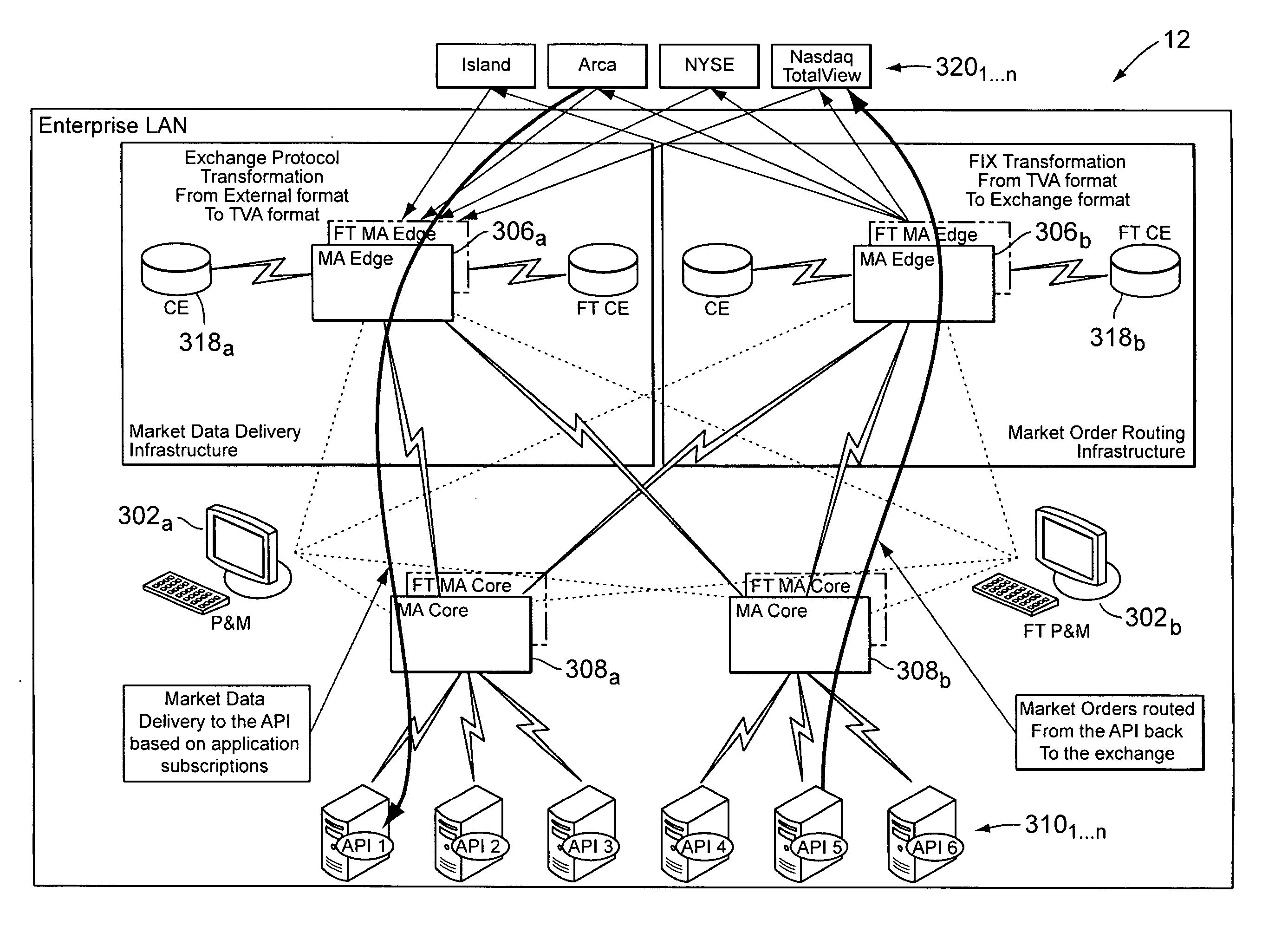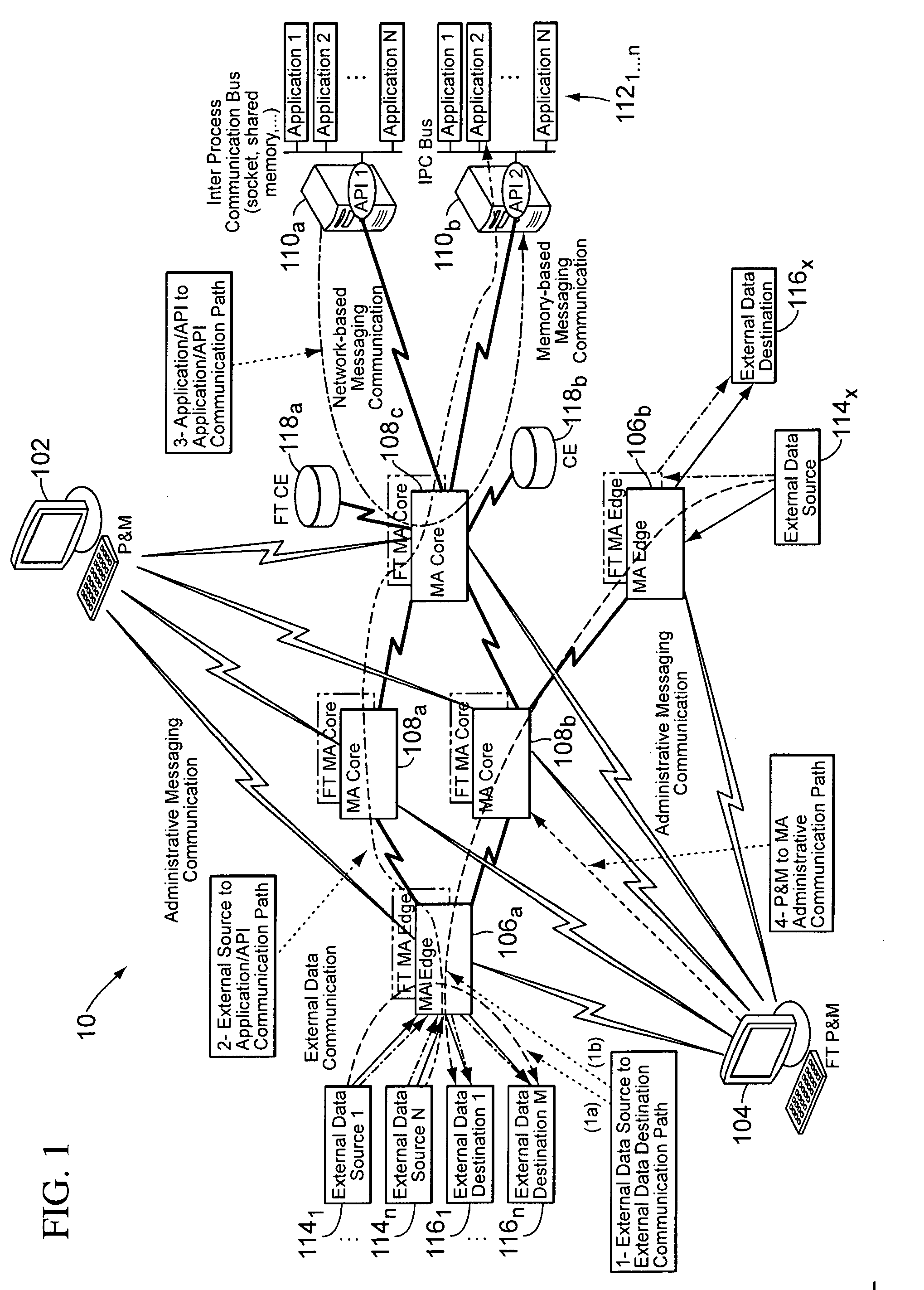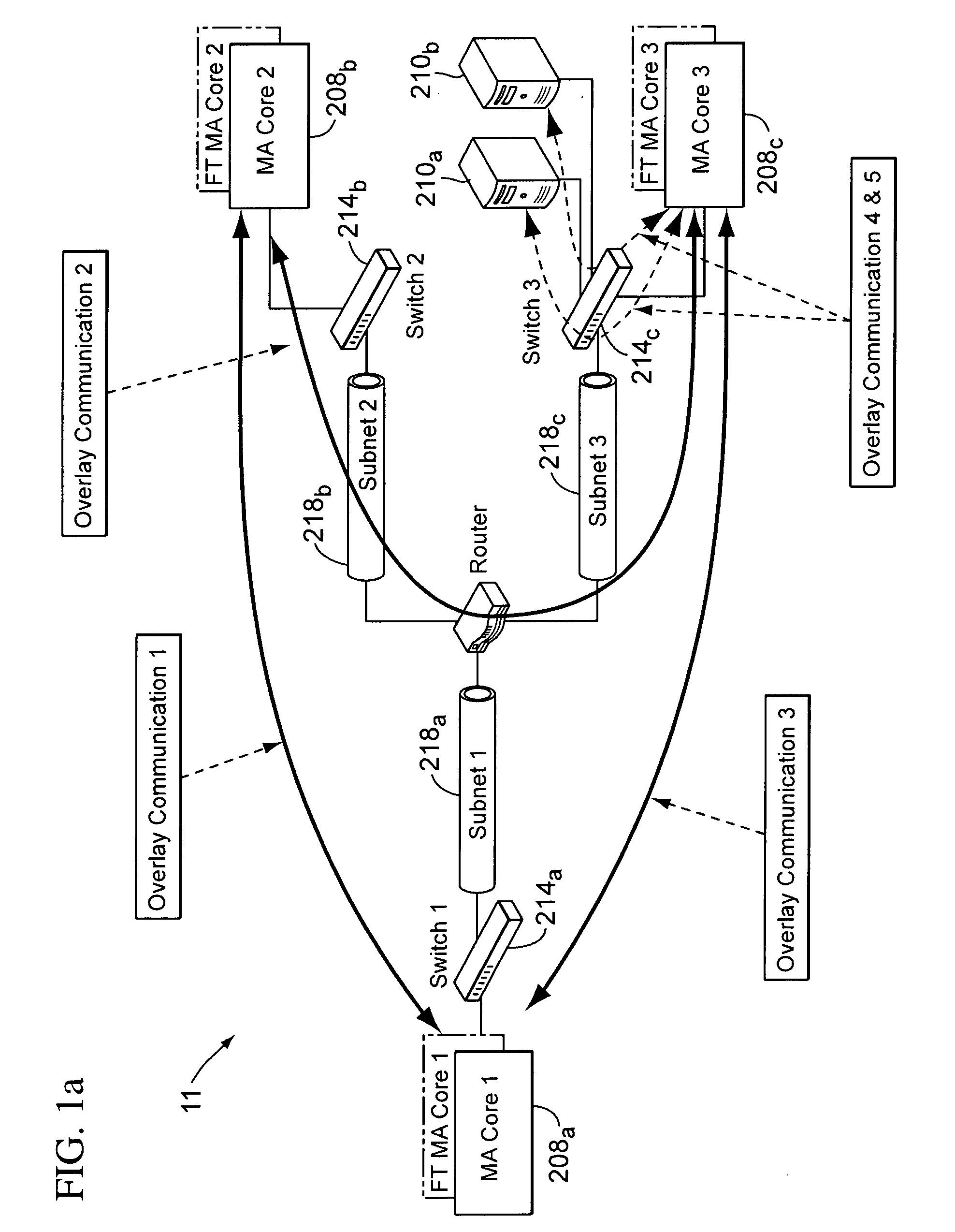Intelligent messaging application programming interface
a programming interface and intelligent technology, applied in the field of data messaging middleware architecture, can solve the problems of scalability and operational problems, messaging system architecture produces latency, and create performance bottlenecks, and achieve the effects of reducing latency, improving performance, and increasing message volum
Inactive Publication Date: 2006-07-27
TERVELA INC
View PDF15 Cites 63 Cited by
- Summary
- Abstract
- Description
- Claims
- Application Information
AI Technical Summary
Benefits of technology
[0013] The present invention is based, in part, on the foregoing observations and on the idea that such deficiencies can be addressed with better results using a different approach. These observations gave rise to the end-to-end message publish / subscribe middleware architecture for high-volume and low-latency messaging and particularly an intelligent messaging application programming interface (API). So therefore, for communications with applications a data distribution system with an end-to-end message publish / subscribe middleware architecture that includes an intelligent messaging API in accordance with the principles of the present invention can advantageously route significantly higher message volumes and with significantly lower latency. To accomplish this, the present invention contemplates, for instance, improving communications between APIs and messaging appliances through reliable, highly-available, session-based fault tolerant design and by introducing various combinations of late schema binding, partial publishing, protocol optimization, real-time channel optimization, value-added calculations definition language, intelligent messaging network interface hardware, DMA (direct memory access) for applications, system performance monitoring, message flow control, message transport logic with temporary caching and value-added message processing.
Problems solved by technology
With the hub-and-spoke system configuration, all communications are transported through the hub, often creating performance bottlenecks when processing high volumes.
Therefore, this messaging system architecture produces latency.
However, such architecture presents scalability and operational problems.
By comparison to a system with the hub-and-spoke configuration, a system with a peer-to-peer configuration creates unnecessary stress on the applications to process and filter data and is only as fast as its slowest consumer or node.
The storage operation is usually done by indexing and writing the messages to disk, which potentially creates performance bottlenecks.
Furthermore, when message volumes increase, the indexing and writing tasks can be even slower and thus, can introduce additional latency.
One common deficiency is that data messaging in existing relies on software that resides at the application level.
This implies that the messaging infrastructure experiences OS (operating system) queuing and network I / O (input / output), which potentially create performance bottlenecks.
Another common deficiency is that existing architectures use data transport protocols statically rather than dynamically even if other protocols might be more suitable under the circumstances.
Indeed, the application programming interface (API) in existing architectures is not designed to switch between transport protocols in real time.
The limitations associated with static (fixed) configuration preclude real time dynamic network reconfiguration.
In other words, existing architectures are configured for a specific transport protocol which is not always suitable for all network data transport load conditions and therefore existing architectures are often incapable of dealing, in real-time, with changes or increased load capacity requirements.
Furthermore, when data messaging is targeted for particular recipients or groups of recipients, existing messaging architectures use routable multicast for transporting data across networks.
However, in a system set up for multicast there is a limitation on the number of multicast groups that can be used to distribute the data and, as a result, the messaging system ends up sending data to destinations which are not subscribed to it (i.e., consumers which are not subscribers of this particular data).
This increases consumers' data processing load and discard rate due to data filtering.
Then, consumers that become overloaded for any reason and cannot keep up with the flow of data eventually drop incoming data and later asks for retransmissions.
Therefore, retransmissions can cause multicast storms and eventually bring the entire networked system down.
When the system is set up for unicast messaging as a way to reduce the discard rate, the messaging system may experience bandwidth saturation because of data duplication.
And, although this solves the problem of consumers filtering out non-subscribed data, unicast transmission is non-scalable and thus not adaptable to substantially large groups of consumers subscribing to a particular data or to a significant overlap in consumption patterns.
Therefore, the overall end-to-end latency increases as the number of hops grows.
Also, when routing messages from publishers to subscribers the message throughput along the path is limited by the slowest node in the path, and there is no way in existing systems to implement end-to-end messaging flow control to overcome this limitation.
One more common deficiency of existing architectures is their slow and often high number of protocol transformations.
Method used
the structure of the environmentally friendly knitted fabric provided by the present invention; figure 2 Flow chart of the yarn wrapping machine for environmentally friendly knitted fabrics and storage devices; image 3 Is the parameter map of the yarn covering machine
View moreImage
Smart Image Click on the blue labels to locate them in the text.
Smart ImageViewing Examples
Examples
Experimental program
Comparison scheme
Effect test
example # 1
EXAMPLE #1
[0078] A string with a wildcard of T1.*.T3.T4 would match T1.T2a.T3.T4 and T1.T2b.T3.T4 but would not match T1.T2.T3.T4.T5
example # 2
EXAMPLE #2
[0079] A string with wildcards of T1.*.T3.T4.* would not match T1.T2a.T3.T4 and T1.T2b.T3.T4 but it would match T1.T2.T3.T4.T5
example # 3
EXAMPLE #3
[0080] A string with wildcards of T1.*.T3.T4[*] (optional 5th element) would match T1.T2a.T3.T4, T1.T2b.T3.T4 and T1.T2.T3.T4.T5 but not match T1.T2.T3.T4.T5.T6
the structure of the environmentally friendly knitted fabric provided by the present invention; figure 2 Flow chart of the yarn wrapping machine for environmentally friendly knitted fabrics and storage devices; image 3 Is the parameter map of the yarn covering machine
Login to View More PUM
 Login to View More
Login to View More Abstract
Message publish / subscribe systems are required to process high message volumes with reduced latency and performance bottlenecks. The intelligent messaging application programming interface (API) introduced by the present invention is designed for high-volume, low-latency messaging. The API is part of a publish / subscribe middleware system. With the API, this system operates to, among other things, monitor system performance, including latency, in real time, employ topic-based and channel-based message communications, and dynamically optimize system interconnect configurations and message transmission protocols.
Description
REFERENCE TO EARLIER-FILED APPLICATIONS [0001] This application claims the benefit of and incorporates by reference U.S. Provisional Application Ser. No. 60 / 641,988, filed Jan. 6, 2005, entitled “Event Router System and Method” and U.S. Provisional Application Ser. No. 60 / 688,983, filed Jun. 8, 2005, entitled “Hybrid Feed Handlers And Latency Measurement.”[0002] This application is related to and incorporates by reference U.S. patent application Ser. No. ______ (Attorney Docket No. 50003-0004), Filed Dec. 23, 2005, entitled “End-To-End Publish / Subscribe Middleware Architecture.”FIELD OF THE INVENTION [0003] The present invention relates to data messaging middleware architecture and more particularly to application programming interface in messaging systems with a publish and subscribe (hereafter “publish / subscribe”) middleware architecture. BACKGROUND [0004] The increasing level of performance required by data messaging infrastructures provides a compelling rationale for advances in...
Claims
the structure of the environmentally friendly knitted fabric provided by the present invention; figure 2 Flow chart of the yarn wrapping machine for environmentally friendly knitted fabrics and storage devices; image 3 Is the parameter map of the yarn covering machine
Login to View More Application Information
Patent Timeline
 Login to View More
Login to View More Patent Type & Authority Applications(United States)
IPC IPC(8): G06F15/173
CPCG06F9/542G06F9/546G06Q10/00H04L12/1895H04L12/58H04L12/5855H04L41/0806H04L41/082H04L41/0879H04L41/0886H04L41/5009H04L43/06H04L43/0817H04L43/0852H04L43/0894H04L51/14H04L67/24H04L67/322H04L67/327H04L67/2852H04L69/18H04L69/40G06F2209/544H04L51/214H04L67/54H04L67/5682H04L67/61H04L67/63H04L51/04H04L51/00
Inventor THOMPSON, J. BARRYSINGH, KULFRAVAL, PIERRE
Owner TERVELA INC
Features
- R&D
- Intellectual Property
- Life Sciences
- Materials
- Tech Scout
Why Patsnap Eureka
- Unparalleled Data Quality
- Higher Quality Content
- 60% Fewer Hallucinations
Social media
Patsnap Eureka Blog
Learn More Browse by: Latest US Patents, China's latest patents, Technical Efficacy Thesaurus, Application Domain, Technology Topic, Popular Technical Reports.
© 2025 PatSnap. All rights reserved.Legal|Privacy policy|Modern Slavery Act Transparency Statement|Sitemap|About US| Contact US: help@patsnap.com



